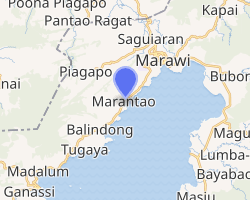Marantao
Marantao, officially the Municipality of Marantao (Maranao: Inged a Marantao; Tagalog: Bayan ng Marantao), is a 2nd class municipality in the province of Lanao del Sur, Philippines. According to the 2015 census, it has a population of 32,974 people.[3]
Marantao | |
|---|---|
| Municipality of Marantao | |
 Map of Lanao del Sur with Marantao highlighted | |
OpenStreetMap 
| |
.svg.png) Marantao Location within the Philippines | |
| Coordinates: 7°57′00″N 124°13′59″E | |
| Country | |
| Region | Bangsamoro Autonomous Region in Muslim Mindanao (BARMM) |
| Province | Lanao del Sur |
| District | 1st District |
| Barangays | 34 (see Barangays) |
| Government | |
| • Type | Sangguniang Bayan |
| • Mayor | Akira I. Alonto |
| • Vice Mayor | Nashriph B. Cornell |
| • Congressman | Ansaruddin Abdul Malik A. Adiong |
| • Electorate | 23,185 voters (2019) |
| Area | |
| • Total | 660.00 km2 (254.83 sq mi) |
| Population (2015 census)[3] | |
| • Total | 32,974 |
| • Density | 50/km2 (130/sq mi) |
| • Households | 4,083 |
| Economy | |
| • Income class | 2nd municipal income class |
| • Poverty incidence | 61.11% (2015)[4] |
| • Revenue (₱) | 127,924,268.48 (2016) |
| Time zone | UTC+8 (PST) |
| ZIP code | 9711 |
| PSGC | |
| IDD : area code | +63 (0)63 |
| Climate type | tropical climate |
| Native languages | Maranao Tagalog |
| Website | www |
Marantao (Merantau) is a Malay word that means "to go on adventure, travel or hunting or even on a war expedition".
Barangays
Marantao is politically subdivided into 34 barangays.
- Bacayawan
- Cawayan Bacolod
- Bacong
- Camalig Bandara Ingud
- Camalig Bubong
- Camalig (Poblacion)
- Inudaran Campong
- Cawayan
- Daanaingud
- Cawayan Kalaw
- Kialdan Proper
- Lumbac Kialdan
- Cawayan Linuk
- Lubo Kialdan
- Inudaran Lumbac
- Mantapoli Kialdan
- Matampay Kialdan
- Maul
- Nataron
- Pagalongan Bacayawan
- Pataimas Kialdan
- Poona Marantao
- Punud Proper
- Tacub
- Maul Ilian
- Palao
- Banga-Pantar
- Batal-Punud
- Bubong Madanding (Bubong)
- Ilian
- Inudaran Loway
- Maul Lumbaca Ingud
- Poblacion
- Tuca Kialdan
Climate
| Climate data for Marantao, Lanao de Sur | |||||||||||||
|---|---|---|---|---|---|---|---|---|---|---|---|---|---|
| Month | Jan | Feb | Mar | Apr | May | Jun | Jul | Aug | Sep | Oct | Nov | Dec | Year |
| Average high °C (°F) | 24 (75) |
24 (75) |
25 (77) |
26 (79) |
26 (79) |
25 (77) |
25 (77) |
25 (77) |
25 (77) |
25 (77) |
25 (77) |
25 (77) |
25 (77) |
| Average low °C (°F) | 20 (68) |
20 (68) |
20 (68) |
20 (68) |
21 (70) |
21 (70) |
20 (68) |
20 (68) |
20 (68) |
20 (68) |
20 (68) |
20 (68) |
20 (68) |
| Average precipitation mm (inches) | 159 (6.3) |
143 (5.6) |
166 (6.5) |
183 (7.2) |
357 (14.1) |
414 (16.3) |
333 (13.1) |
309 (12.2) |
289 (11.4) |
285 (11.2) |
253 (10.0) |
166 (6.5) |
3,057 (120.4) |
| Average rainy days | 18.4 | 17.2 | 20.6 | 23.4 | 29.3 | 29.2 | 29.9 | 29.4 | 27.7 | 28.7 | 25.5 | 19.9 | 299.2 |
| Source: Meteoblue [5] | |||||||||||||
Demographics
| Year | Pop. | ±% p.a. |
|---|---|---|
| 1918 | 3,640 | — |
| 1939 | 6,783 | +3.01% |
| 1948 | 2,494 | −10.52% |
| 1960 | 13,720 | +15.26% |
| 1970 | 15,861 | +1.46% |
| 1975 | 16,496 | +0.79% |
| 1980 | 11,777 | −6.52% |
| 1990 | 18,404 | +4.57% |
| 1995 | 20,942 | +2.45% |
| 2000 | 24,647 | +3.55% |
| 2007 | 32,075 | +3.70% |
| 2010 | 28,550 | −4.15% |
| 2015 | 32,974 | +2.78% |
| Source: Philippine Statistics Authority[3][6][7] | ||
Kawayan Torogan
The Kawayan Torogan is the oldest known torogan in the Philippines. It is a traditional Maranao house built for royal Maranao families. There was once a campaign where the people wanted the municipalities of Marantao and Tugaya to pass an ordinance where the architectural scheme of the two towns will follow only the totogan style, in effect, preserve the Maranao people's most royal architectural style and lead to the first two towns with a planned town landscape under an indigenous Maranao architecture. However, the campaign led to deaf ears due to little funding available.
References
- "Municipality". Quezon City, Philippines: Department of the Interior and Local Government. Retrieved 31 May 2013.
- "Province: Lanao del Sur". PSGC Interactive. Quezon City, Philippines: Philippine Statistics Authority. Retrieved 12 November 2016.
- Census of Population (2015). "ARMM – Autonomous Region in Muslim Mindanao". Total Population by Province, City, Municipality and Barangay. PSA. Retrieved 20 June 2016.
- "PSA releases the 2015 Municipal and City Level Poverty Estimates". Quezon City, Philippines. Retrieved 12 October 2019.
- "Marantao, Lanao del Sur : Average Temperatures and Rainfall". Meteoblue. Retrieved 27 January 2019.
- Census of Population and Housing (2010). "ARMM – Autonomous Region in Muslim Mindanao". Total Population by Province, City, Municipality and Barangay. NSO. Retrieved 29 June 2016.
- Censuses of Population (1903–2007). "ARMM – Autonomous Region in Muslim Mindanao". Table 1. Population Enumerated in Various Censuses by Province/Highly Urbanized City: 1903 to 2007. NSO.
External links
- Marantao Profile at PhilAtlas.com
- Philippine Standard Geographic Code
- Philippine Census Information
- Local Governance Performance Management System